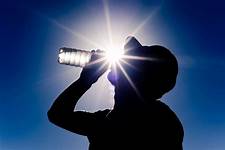Extreme heat or heat waves occur when the temperature reaches extremely high levels or when the combination of heat and humidity causes the air to become oppressive.
Hazardous heat exposure can occur indoors or outdoors, and can occur during any season if the conditions are right, not only during heat waves.
Symptoms and First Aid
Heat illness or heat-related illnesses are disorders due to environmental heat exposure. It includes minor conditions such as transient heat fatigue, heat rash, heat cramps, and heat exhaustion as well as the more severe condition known as heat stroke.

- Accuweather
- Air Now Mobile App
- CalOSHA Regulation (CCR Title 8, §3395)
- CalOSHA Indoor Heat Requirements (CCR Title 8, §3396)
- CDC OSHA-NIOSH Heat Safety Tool App
- DOSH Heat Illness Prevention
- National Weather Service
- Purple Air (Real time air quality map)
- Water - Rest - Shade Campaign (OSHA)
- Web Bulb Globe Temperature
Transient Heat Fatigue is the temporary state of discomfort and mental or psychological strain arising from prolonged heat exposure.
Heat Rash, also known as prickly heat, is likely to occur in hot, humid environments where sweat is not easliy removed from the surface of the skin by evaporation, and the skin remains wet most of the time.
Symptoms:
- Skin redness and pain
- Possible swelling
- Blisters
- Fever
- Headaches
First Aid:
- Take a shower using mild soap
- Apply dry, sterile dressings to any blisters
- Seek medical attention
Heat cramps are painful spasms of the muscles that occur among those who sweat profusely in heat and drink large quantitities of water, but do not adequately replace the body's salt loss.
Symptoms:
- Painful Spasms usually in the leg and abdominal muscles
- Heavy Sweating
First Aid:
-
Move victim to a coller location
- Lightly stretch and gently massage affected muscles
- Give sips of up to a half glass of cool water every 15 minutes
- Discontinue liquids if victim is nauseated
Heat exhaustion is caused by the loss of large amounts of fluid by sweating, sometimes with excessive loss of salt.
Symptoms:
- Heavy sweating
- Weak pulse
- Body temperature is normal or slightly higher
- Fainting, dizziness, nausea, vomiting, exhaustion, and headaches
First aid:
- Move victim into shade
- Loose and remove clothing
- Cool the victim (wet cloth, spray mist)
- Have victim slowly drink water
- Seek medical aid immediately if vomiting occurs
Heat stroke, the most serious heat illness, is failure of the body's internal mechanism to regulate it's core temperature.
Symptoms:
- Body temperature rise to fatal levels
- Hot, red, dry skin
- Rapid, weak pulse
- Rapid shallow breathing
- No sweating
- Possible unconsciousness
First aid:
- Call 9-1-1 for emergency help immediately
- Move victim into shade
- Loosen or remove outer clothing
- Lower body temperature (massage body with ice or damp cloth)
- Watch for breathing problems
When heat illness occurs:
- Call 9-1-1 (from a campus phone or cell phone) for emergency medical help
- Tell the dispatcher this is a heat related illness
- If the individual is an employee, notify their supervisor
- The supervisor should fill out a Supervisor Report of Injury.
Updated: August 01, 2024